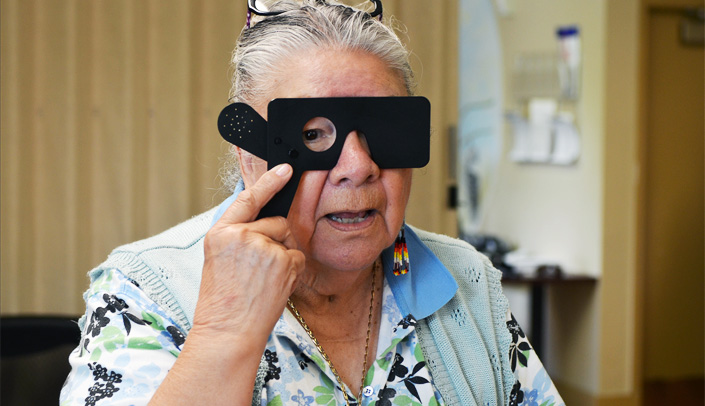She traveled three hours from Wagner, S.D., to Omaha, for her eye appointment, but for Conceta Zephier, 80, it was well worth the trip.
Her eyesight is vital to see the drawings and craft projects her grandchildren make, the Ponca tribal elder said.
And it makes her proud to come to her own tribe’s clinic to receive care.
“Just looking at the eye chart on the wall with the eagle mural next to it makes me feel more at home,” Zephier said.
Zephier was one of 224 American Indians who received free comprehensive eye exams during a five-day clinic held in June at the Fred LeRoy Health and Wellness Center in south Omaha.
In partnership with the Ponca Tribe of Nebraska, the UNMC Truhlsen Eye Institute’s Prevention of Global Blindness Division provided an ophthalmologist, a fellow, residents and medical students to perform the eye exams.
Situated in the middle of an inner-city neighborhood, the three-story health and wellness center is the medical home for more than 6,000 American Indians representing 157 different tribes. The clinic, which incorporates traditional practices in the care provided, includes a small pharmacy and medical, dental and behavioral health services.
American Indians from Lincoln, Norfolk, Niobrara, Sioux City, Omaha and South Dakota received eye care that week; for many, it was their first comprehensive eye exam by an ophthalmologist.
“A majority of the people we serve have no health insurance and many rely on Indian Health Services to provide care,” said Becci White, tribal health planner and Ponca tribal member.
“Because of a lack of funding, we are unable to provide all the preventive care we would like so this partnership with UNMC fills a desperately needed gap.”
Throughout the week patients were diagnosed with a variety of issues including glaucoma, cataracts, macular degeneration, corneal dystrophy and a suspected case of a retinal vascular abnormality that could be life-threatening.
“So many people in the world suffer needlessly with blindness or various types of eye disease that can lead to blindness if left untreated,” said Mike Feilmeier, M.D., chief of the Prevention of Global Blindness Division. “It’s part of our mission to reach out to those people wherever they are, whether that is in a third world nation or in our own back yard.”
